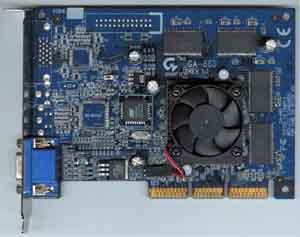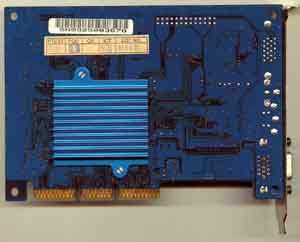The Card
The Gigabyte GA-660's PCB's color is the first thing that jumps out at you when you get a hold of the card. It's dark blue color isn't anything new, but it is quite rare and offers a nice change of pace in this green and orange PCB world. Otherwise, the GA-660's PCB is pretty much a standard reference TNT2 design with no TV-out options. The memory consists of four 8MB Samsung 7ns SDRAM chips. The GA-660F provides a digital flat panel output, but still not TV-out.
The GA-660 is based on the "standard" version of the TNT2 chipset, which according to NVIDIA, indicates that the core clock speed and the memory clock speed should be no less than 125MHz and 150MHz respectively. However, NVIDIA has left the exact clock speeds up to the manufacturers and many have chosen to ship at higher than these recommended clock speeds.
However, Gigabyte apparently knew as well as we do that even the standard TNT2 has a lot more in it. They decided to follow NVIDIA's recommendation and ship the card at 125/150, but has included a turbo jumper on board. What's this jumper do? It cranks the speed up to 156/156 by loading a slightly different BIOS. With careful cooling of the TNT2 processor, they feel that all their boards should all be able to hit this higher speed. You could even attach that virtually useless turbo switch some cases still have to the jumper header and have a quick little way to overclock your TNT2 without the use of any software utilities. Unfortunately, a reboot is required to effect a change with the jumper since the card BIOS must be reinitialized to recognize the new setting, so you won't be able to just hit the button when it's time to game.
Speaking of that cooling, Gigabyte is the first manufacturer AnandTech has seen put a heatsink on both sides of a video card. On the backside of the card, exactly behind the TNT2 core, is a large, very low profile blue heatsink. The heatsink on the backside of a chip is a trick that overclockers have used for quite a while with both CPU's and video cards. It was only a matter of time before a manufacturer picked up on it.
The primary heatsink (the one on the front of the card) is very similar to that of the Hercules Dynamite TNT2. While that card was able to reach 190MHz core with just a heatsink, our Gigabyte was "only" able to obtain 175MHz. Our Dynamite TNT2 most likely had an exceptional core, and 175MHz for the core is well beyond NVIDIA's recommended clock speed for a TNT2 Ultra, not to mention the standard TNT2 that's actually in use here. The 7ns Samsung memory keeps the memory clock down to a maximum of 160MHz. As such, core clock speed increases beyond 160MHz give diminishing returns in terms of performance.
The 2D image quality of the Gigabyte GA-660 follows the pattern of other TNT2's out there - it is fine at resolutions up to 1280 x 1024, but at 1600 x 1200 the image quality takes a noticeable dive. Although it is noticeably better than the best TNT cards in terms of 2D image quality most TNT2 based cards, aren't too friendly on your eyes at 1600 x 1200 and above. If you're really looking for a combination of a professional/gaming card then Matrox's G400/G400MAX is probably what you should be setting your sights on, unfortunately getting one of those hot items is easier said than done.












0 Comments
View All Comments